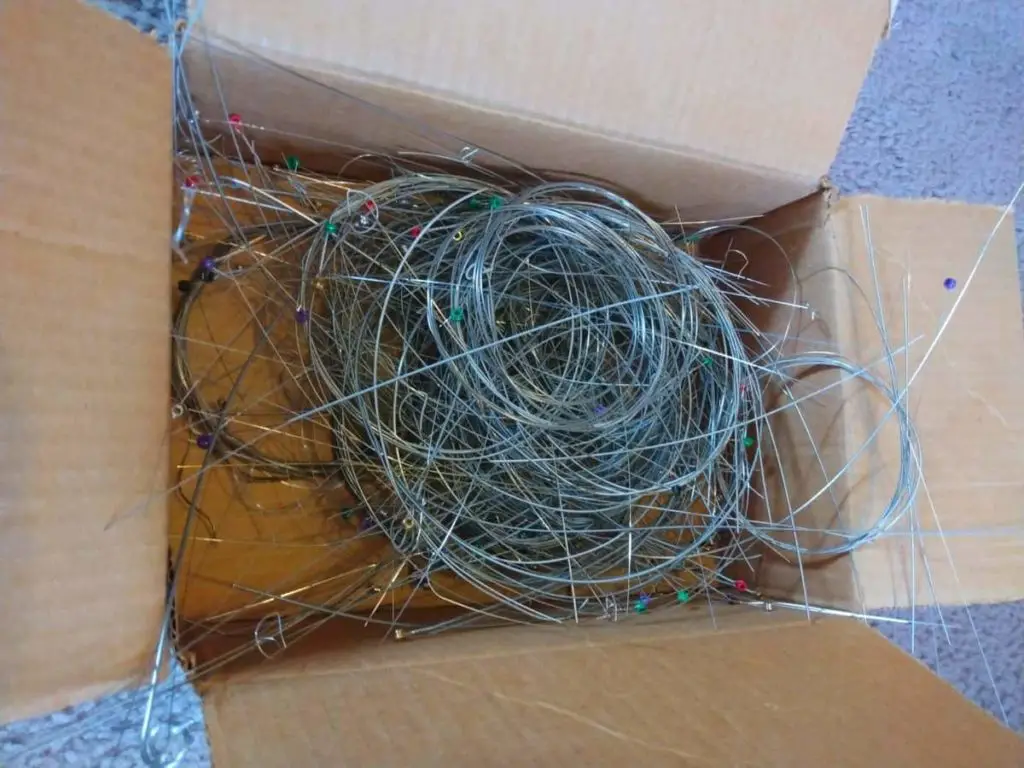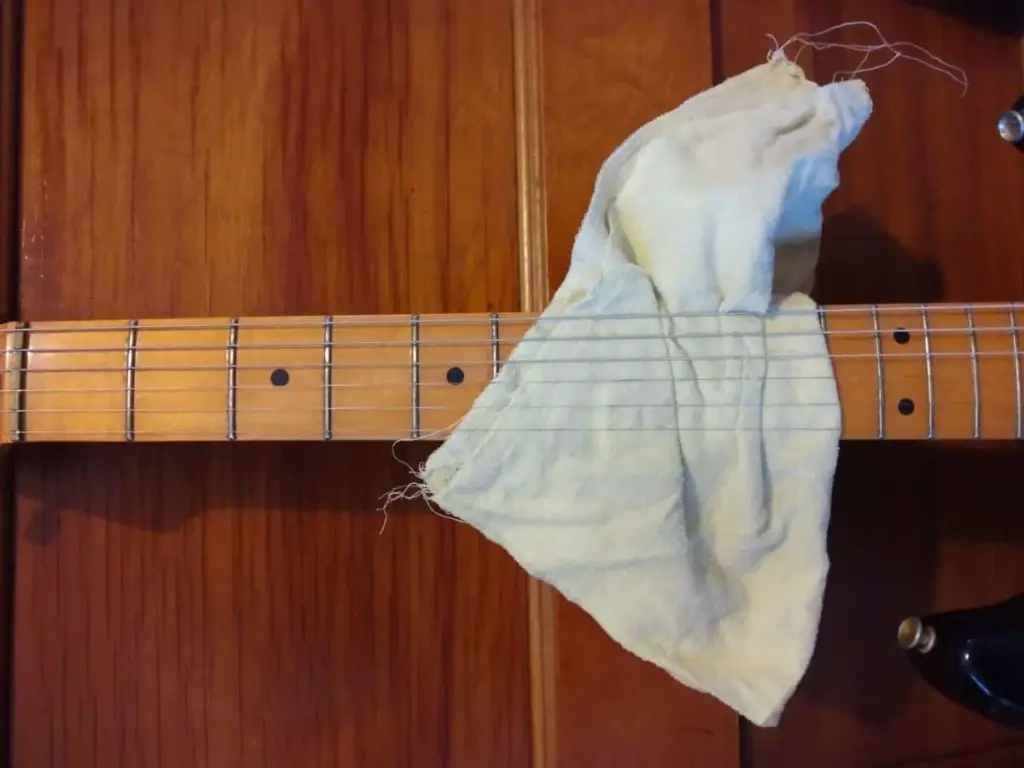Today I am going to talk about how and why guitar strings snap or break. As a professional guitarist, I have snapped many strings over the years. I have also learned how to extend the life of guitar strings. So, let’s take a closer look at why they break.
Guitar strings do break and the primary causes are usually wear, age, and tension. It is most common to break strings while playing rock, blues, metal, and other intense styles of music. The quality of your strings and quality of your guitar are factors as well.
Now let’s dive into the details you’ll want to know.

Do Guitar Strings Break While Playing?
Guitar strings can snap while playing. The most common time to break a string is while bending. This often happens when playing intense blues, rock, or metal music. Electric guitar strings are very thin pieces of metal (usually steel, nickel, or bronze). They are not invincible.
Some guitars use nylon strings. While nylon is not as durable as metal, these strings are generally played with less intensity than metal strings.
The worst time to snap a string is during a live performance. This is why professional guitarists keep at least two guitars available to play. They also carry extra strings, and a string winder for fast string changing. However, if you change your strings often enough, this situation is generally avoidable.
Do Guitar Strings Break While Tuning?
It is possible for strings to break while tuning, but if you have a quality, well-maintained guitar, and you use proper string fastening technique, this should not be an issue.
Tuning a guitar string up in pitch raises the tension of the string. If you tighten the string significantly higher than what it was designed for, there is a risk of breaking it. Find the pitch you are tuning to on a keyboard, app, or tuner and do not go higher than the specified pitch.
Make sure not to make any kinks in the strings when fastening them to your guitar. Do not bend, fold, or crease the strings. Any kinks will become weak spots in the string. Straight strings will play with more accurate pitch.
Do Guitar Strings Break on Their Own?
It is very unlikely that a guitar string will snap on its own. Avoid extreme hot and cold temperatures and if possible, allow your guitar to return to approximately room temperature before taking it out of its case.
Wood expands in hot temperatures and contracts in cold temperatures. It is best to allow this to happen gradually. If you have to bring your guitar into a hot environment, detune the strings slightly, then retune when the guitar is acclimated to the high temperature.
What Causes a Guitar String to Break
There are several reasons why guitar strings snap. These reasons generally relate to what strings you use and how you use them. By keeping these things in mind, you can extend the life of your strings.
1) Wear to Strings
The more a string is used, the more worn it becomes. Bending, wear from the frets, and sweat from your hands all contribute to the string wearing out and becoming more prone to snapping. Wear also affects tone and intonation (playing in tune), so its important to keep your strings relatively fresh.
2) Thin Strings
Thin strings break more easily than thick strings. If breaking strings is a major concern for you, try a set of .11s or higher. Keep in mind these will be more effort to play and especially to bend.
It is more common to break the High E, B, and G strings, but it is possible to snap the lower strings as well. The lower strings may begin to unwind, or snap entirely.
3) Bending and Intense Playing
Bending, intense strumming, and other strenuous techniques increase the chances of a string snapping. Anything that increases tension will test the durability of the string. Using thicker strings is recommended if you play with high intensity.
4) Issues with Contact Points (Bridge Saddles, Nut)
If there is a sharp area or other irregularity at your bridge or nut, it can cause a string to snap. If you have this issue, the string will likely break early and often until you solve the problem.
I recommend having your guitar examined by a professional. They may file or replace certain parts. If you are confident and willing to take some risk, you can do these things on your own. I recommend doing research before hand.
Most guitarists are better off leaving their instrument with a qualified professional.
5) Fastening strings improperly
The proper way to fasten new strings depends on the model of your guitar. Typically, electric guitar strings are routed through a tail piece or through the back of the guitar. They are then placed in their individual bridge saddles, through the nut, then through the tuning pegs.
Leave some slack so that the string can wind around its tuning peg a few times before reaching pitch. Be careful when unraveling new strings and when putting them on. Ideally there will be no bends or kinks in the string. Any kinks will become a vulnerable point in the string.
Once your string is on, you can clip off the end with wire cutters. If you do not have a wire cutter handy, you can make a severe kink in the string, then move the excess part back and forth until the string snaps.
6) Over-tightening
Do not over tighten the strings. Know the exact pitch you are tuning to and tune from flat up to pitch.
When all the strings are tuned to pitch, give each one a firm (but not aggressive) tug. This helps the string stretch and settle and stay in tune better. If you tighten your strings too much they may break or unwind.
The Low E, A, and D strings are typically wound, meaning that they are made with a wire wrapped tightly around a core wire. If a string repeatedly becomes dramatically flat, give a tug and see if the string is unwinding. If that is the case, the string is useless and needs to be changed.
What Happens When a Guitar String Snap (What It Feels Like)
In all my years of playing I can’t remember a single time when snapping a string hurt me.
It is more common to be poked by the tip of the string when removing it or when fastening a new one. This usually happens to the tip of your finger. It feels like getting poked with a pin and you may see a dot of blood.
Just wash the area, and let it heal. There is no cause for concern. Some guitarists like to wind some excess string into a curl at the tuning peg. This curl is more flexible than a short tip and is less likely to poke you.

Do Guitar Strings Snap Easily?
A good quality string (I use D’addario brand) should not snap easily. Thinner gauge strings (below .10) are more prone to breaking but are still resilient if used properly. There are many videos on youtube that demonstrate proper string changing technique.
Do Old Guitar Strings Snap Easier?
Older strings are more prone to snapping, however, wear and use are more relevant than age. You should change your strings when it seems appropriate. This will depend on your style of playing and how much you play.
You can extend string life by wiping the strings with a soft cloth after each playing session. Doing this keeps the strings clean and prevents oxidation. Newer, cleaner strings sound clearer and play with more accurate pitch.
I heard one professional guitarist say that his strings are changed every day for best consistency. When you notice your strings becoming dirty, dark, gritty, or dented, you should change them soon.
How Often Do Guitar Strings Snap?
The durability of your strings depends on the quality of the strings, good string changing technique, the quality of the guitar parts (especially the bridge and saddles), caring for your strings, your playing technique, and the gauge of strings that you use.
Considering all these factors there is no specific expectation of how long a string should last. You will develop a sense of when your strings need changing. I recommend changing your strings at least every two to six months.
If you play a lot, you might reduce this interval to every month or less. I play a lot and typically change my strings every two months. I don’t think I have broken a string since I began this habit.
How to Tell if Your Guitar Strings Are About to Snap
You cannot always tell when strings are going to snap. If your strings show indentations where they meet the frets, or if they look, sound, or feel dark, dull, or dirty, it may be time to change them.
Some guitarists prefer to play with older strings. It does reduce brightness which can be a desirable quality. However, if you are playing live, or doing an important recording session, it is probably better to change them.
Tips to Prevent Your Guitar Strings From Snapping
There are several things a guitarist can do to extend the life of their strings. These tips regard which strings and parts you use, and how you use and care for them.
1) Change Your Strings When They Need Changing
Change your strings before they become excessively worn. This will depend on how much you play and what style you play.
Most players will want to change their string every two to four months. If you are a very serious player that may lower to every month or every week. Some players really like the freshness and consistency of new strings.
2) Learn to Bend Correctly
Typically, bending is done by fretting a note and pushing the string out of its normal position.
The amount the string must move depends on how much you want to increase the pitch, and also, the thickness of the string. Thin strings must be bent further, and are also easier to bend. Thick strings do not have to be bent as far, but are more difficult to bend.
Bending the string temporarily increases its tension and chances its of snapping. The point where the string meets the bridge saddle is particularly vulnerable when bending.
3) Bridge and Nut
If your strings repeatedly break in the same location on the string, bring your guitar to a repair shop and explain or leave a note explaining the issue. Sometimes an issue with the bridge saddle or nut can cause strings to snap easily and repeatedly.
After you snap a string, before removing it, lay the string along its normal position and try to determine where the string broke. Was it at the bridge saddle, nut, tuning post, or somewhere in the middle? Finding the point at which the string broke will likely give you a clue as to what caused the break.
4) Wipe Strings After Playing
The sweat from your hands will make your strings wear out faster. To prevent this, use a cloth to pinch the string and glide along the length of the string. Do this with each string after each playing session to extend the tone and life of your strings.

5) Use Quality Strings
Use quality strings by a well known brand. A few good options are D’addario, Ernie Ball, and LaBella.
Guitar strings are made from a few different metals and alloys. I recommend using steel strings for the most durability.
If you play acoustic guitar you might experiment with bronze strings. If you play classical acoustic you will want to use nylon strings. Nylon strings do not work with electric guitar pick ups because pick ups rely on magnetism.
6) Use Thicker Strings
Sets with a thin string of .10 or higher are more durable than thinner sets. I Tend to use .10s or .11s on my rock guitars and .12s on my jazz guitars. Since I do not bend while playing jazz, the thickness does not hinder me. It is possible to bend thicker strings, but it is more difficult.
If you are a beginner, I recommend using .10s. They have a good balance of tone, bend-ability, and durability.